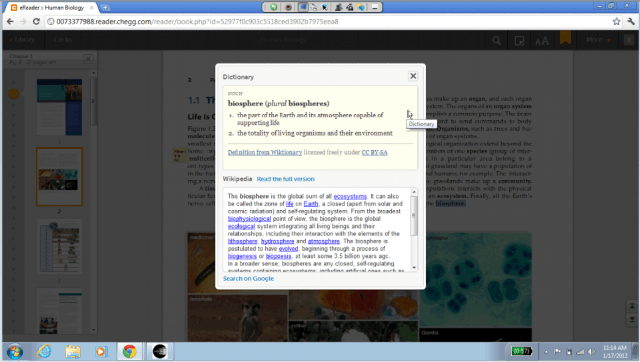Chegg’s digital textbook reader is the “nice guy:” comfortable, treats you right, but doesn’t come with many exciting twists.
“[E-readers] are built for reading purposes, not studying purposes,” said Brent Tworetzky, product leader for Chegg, in an interview with VentureBeat. “We wanted to create an environment that works where students need it.”
Digital textbooks are quickly replacing the traditional, heavy, and cumbersome books of semesters past. This is especially the case as laptops replace notebooks and the sound of clicking becomes expected white noise against the teacher’s voice. Many companies have taken to converting textbooks to PDFs, but that’s it, they’re just PDFs. It’s the same clunky textbook, just now without the weight. Companies such as Kno and Inkling are trying to insert interaction and beauty to the textbook, but need to build a user base and grow textbook offerings. Even Apple seems to be poised to announce its own plan for publishing textbooks.
Chegg, however, saw an opportunity to serve its 4.5 million users by creating an HTML5 digital textbook reader, that can work on any device and utilizes both its suite of education tools and the students who use them.
Chegg has spent the last year acquiring a number of companies and using them to create a comprehensive collection of education products. The company currently offers textbook rentals — its bread and butter — along with homework help, course reviews, and other products aimed at helping students through their years of higher education. Recently, Chegg acquired design firm 3D3R, whose talents have been used to create the new digital textbook reader.
The reader is pretty standard, which may be to Chegg’s benefit. Pages in the textbook look like they would in a textbook, you can highlight text, add notes in the margins, and it will sort your highlights and notes into study guides for you to reference. It also connects you to Chegg’s homework help product, allowing you to ask a question about a certain piece of content, and receive an answer from the Chegg community. It also lets you see the most pertinent areas of text by pre-highlighting what areas of a page the Chegg community is interacting with the most. The reader is free, though the textbooks obviously are not. And because it is built in HTML5, you can access it from iPads, Androids, laptops, library computers, phones, wherever you are.
The company calls it an e-reader, which is a bit misleading given that “e-reader” has become synonymous with hardware such as Kindles and Nooks. Really, it is just a cloud-based piece of software. But honestly, it is the lack of frills that may make this reader a success. For instance, Inkling is gorgeous. The company’s iPad app reinvents the textbook, taking it out of its original form and into interactive pages that are as beautiful as they are functional. But sometimes too much of a good thing is too much. Functional is good, but practical is better. Chegg’s reader is more accessible, with more available textbooks.
“It’s what HTML5 can do,” explained Chegg’s chief executive officer Dan Rosensweig of the reader’s accessibility. “The key here is that a lot of these readers that you use, you choose one device, that’s it.”
Rosensweig says we are “going to see other increasingly trying to follow” in the footsteps of HTML5 reading.
VentureBeat's mission is to be a digital town square for technical decision-makers to gain knowledge about transformative enterprise technology and transact. Learn More


